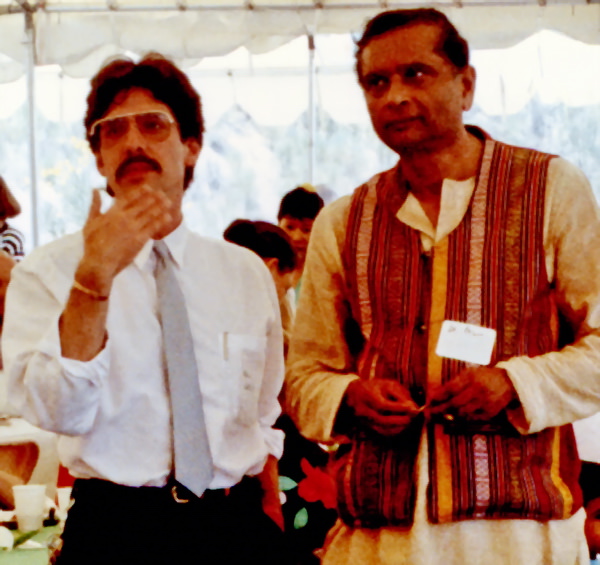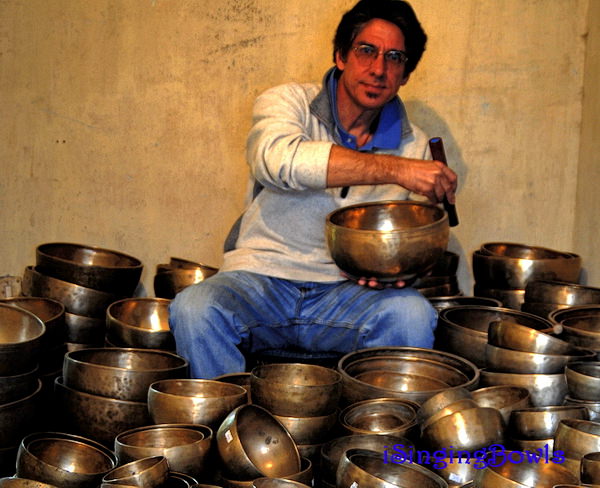- Home
- FAQs
FAQs
How do you know how old the Tibetan singing bowls are?
Rain Gray, founder of iSingingBowls, is an experienced international dealer and expert of Indo-Tibetan bronzes at the museum level. His extensive knowledge and experience, gained over the past 41 years of studies in this field, are applied to the dating of the Tibetan Singing Bowls.
Specifically Rain compares the accumulated wear caused over years of usage, handling and ritual washing-- and other elements such as stylistic changes in the shapes of the bowls and the surface structure of the metal-- against a data base of bowls with original inscriptions which include actual dates.

Rain Gray with Dr. Pratapaditya Pal (then Curator of Indian andSoutheast Asian Art at the Los Angeles County Museum of Art, Los Angeles,California) at a birthday party for His Holiness the Dalai Lama heldin Malibu, California, July 6, 1987.
Antique singing bowls collected by Rain in the Himalayas have been sold to the following museums:
LACMA (Los Angeles County Museum of Art), Los Angeles, California
Asian Art Museum of San Francisco, San Francisco, California
Pacific Asia Museum, Pasadena California
Bowers Museum, Santa Ana, California
San Diego Museum of Art, San Diego, California
Mingei International Museum, San Diego, California
Rubin Museum, New York City, New York
-------------------------------------------------
Where do you get the Tibetan singing bowls?
Rain spends 5 to 12 month each year in the Himalayas personally selecting each of the Tibetan Singing Bowls offered by our company. Having lived and worked in the Himalayas over the past 41 years he has built up a large network of people who collect our bowls.
We deal primarily with 12 different families, one of which we are now dealing with the third generation (having dealt with the grandfather, the father and now son who is presently managing their business). These 12 families have a large network of collectors who travel from village to village throughout the Himalayas trading for the singing bowls.
These are brought out of the mountains and consolidated, then the finest pieces are set aside and kept until Rain returns to the Himalayas to grade them and make his personal selection according to age, harmonic balance, ease and smoothness of playing, sound volume and long sustain.

Tibetan musicologist, meditator and musician, Rain Gray selecting Tibetan singing bowls at the house of one of our suppliers in the Himalayas.
Rain personally tests tens of thousands of singing bowls each year in the
Himalayas to select the 1/2 percent (1 out of 200!)which are awarded our Legendary-quality label.
-------------------------------------------------
Why are your bowls more expensive than bowls from other sellers?
Simply put, we pay more. In order to have the top quality bowls saved for us, and in order to get first pick, we pay a premium. Therefore, our Himalayan collectors and consolidators are always happy to put aside the top pieces for us. After we have skimmed off the cream of the crop, the pick of the litter, the remaining bowls are then offered to other buyers. Keep in mind that we only select and buy the top 1/2 percent (1 singing bowl out of 200)! We have always found that one gets what one pays for and are happy to pay a premium for the best bowls. The difference between the best, what we call "Legendary-quality", and the other 99.5% of the bowls that we reject can be enormous.
Basically, we decided from the inception of our company that we would only offer the best to our customers. We have found that a bowl that is harmonically balanced will greatly help to put the user into a balanced state. Whereas the rejected 99.5% of bowls, which are harmonically un-balanced or out of tune, can actually put the user into a discordant state. If you want to create harmony and balance then it's wise to use a bowl that is harmonically balanced.
-------------------------------------------------
How do the sounds of the bowls relate to the chakras?
There are over 14 different systems that equate the notes of the Western scale to the chakras. Ten of these systems agree that the notes work upon the chakras as follows:
B = crown/ 7th chakra
A = third eye (pineal gland)/ 6th chakra
G = throat/ 5th chakra
F = heart/ 4th chakra
E = solar plexus/ 3rd chakra
D = sacral/ 2nd chakra
C = root/1st chakra
Please note that most of the Tibetan singing bowls produce more than one note and can therefore affect more than one chakra. However, those who are doing healing work will want to acquire a set of bowls that will be able to affect all of the chakras. Please email or call to discuss options for having us put together a matched set according to your budget and needs.
-------------------------------------------------
What is the difference between Tibetan and "crystal" singing bowls?
The silicone glass, or as they are popularly called "crystal" bowls, produce what is scientifically called a pure sine tone. Basically, this is one pure, and in the case of the crystal bowls, intense tone as opposed to the complex harmonics and microtones which are produced by the Tibetan singing bowls. Most people find that the Tibetan singing bowls have a mellower feel compared to the intense tones of the crystal bowls.
-------------------------------------------------
What's the difference between old bowls and new bowls?
Around 1997 new-made singing bowls started showing up in the Himalayan marketplace and subsequently in markets around the world. These bowls which now come in a variety of sizes, some with various Tibetan Buddhist design motifs. They can usually be identified by their highly polished finish, though some are oxidized with a dark finish and some also have either etched or bright gold design motifs.
Although these new hand-forged bell-metal bronze singing bowls are now readily available in the market, just like the best antique singing bowls, only a very small amount of them (1/2 a percent) are really great. However, we find that the antique bowls have a mellower and smoother sound. It's like fine wine, ie. the age lends a mellowness to the sound.
-------------------------------------------------
How do I find a bowl that's right for me?
It's a matter of deep listening, and hearing with your heart! It's best to close your eyes as this will allow you to hear at a deeper level since the part of your brain which normally processes visual information will be freed up to concentrate more fully on auditory input. Feel the sounds and realize how they make you feel and where they are being felt in your body.
It's a process of elimination. By comparing different bowls against each other you will discover which bowl or bowls are right for you. This is the bowl, or bowls, you should choose for your meditation and healing work as they are the ones in harmony with you.
Don't worry. . . you will know when you hear your bowl!
-------------------------------------------------
How do I select a singing bowl for a gift?
Follow the process mentioned above, keeping the person who will receive the gift in your mind/consciousness.
Note that all our products come with a 30-day Money-Back Guarantee so the gift recipient can also view and listen to our present inventory on iSingingBowls.com during this time to hear other bowls if they would like to exchange it for one that they like better.
Or, just purchase a Gift Certificates by clicking HERE. Then they can pick out the one(s) which resonate with them.
-------------------------------------------------
 Loading... Please wait...
Loading... Please wait...
 USD
USD












